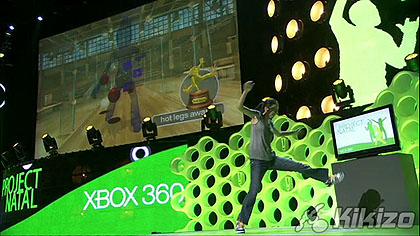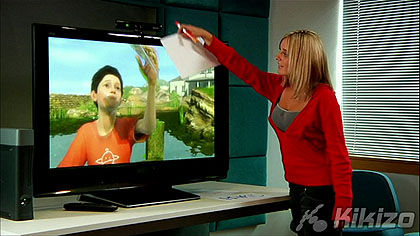First-Hand with Natal:
Why it's a Bigger Deal Than Critics Think
We present to you our info-packed, first-hand, behind closed doors impressions of Xbox 360's stunning new killer app, chat to Kudo Tsunoda and Peter Molyneux, and explain why some of its critics are really missing the point.

At a dinner party last year, British game designer Peter Molyneux told me he and Microsoft wanted to "shock and awe" the industry at GDC with the unveiling of his long-shrouded, top-secret 'Dimitri' project. They may have missed its originally planned GDC unveiling in March, but "shock and awe" is exactly what they did at E3 in Los Angeles last week, with the unveiling of Natal.
At the end of Microsoft's E3 press conference, I was left speechless when Natal was revealed. Thinking about Natal's potential, I'd say it's one of the most inspiring things I've seen revealed at a press conference in well over ten years of sitting through them. However, not everyone is as convinced as I am.
Natal is a new peripheral for Xbox 360 that currently exists in a very early work-in-progress form. This new, 'full body motion sensing' technology may be revolutionary for interactive entertainment, and quite frankly, leaves things like EyeToy, Wii MotionPlus, and Sony's new motion sensing controllers for PS3 - also revealed last week - in the dust. Anyone who doesn't yet understand why, this article is for you.
There's a lot of positive buzz about Natal, but I was surprised to see how much doubt and even indifference there is about it after talking to everyone about it over the last week. Critics and fence-sitters of Natal seem to consistently be saying one of only a few things against it. I'm going to explain why they're missing the point, and why this thing is the real deal, based on my first-hand experience with it behind closed doors, as well as chats with project manager Branden Powell, and the heavyweight developers who showed it off, Kudo Tsunoda and Peter Molyneux.
The first thing detractors are saying is that we, as serious gamers, aren't interested in jumping about in front of the TV. The second thing they're saying is that there is no release date in sight. And the final thing they're saying is that they get it, but they just don't believe that it works - and that they noticed glitches and bugs when it was demonstrated at the conference.
OK, so first off, serious gamers aren't interested in jumping about in front of the TV. Right? Irrelevant. David Cage, developer of promising PS3 exclusive Heavy Rain, is one of the people in this category - this was his sentiment when I asked his opinion on Natal last week. And yet, the very next question I asked him about Sony's newly unveiled motion controller, provoked a more positive, "variety is good" type response. This sort of illustrates my point: everyone who's trying to innovate with motion control is in the same boat here, so to make the demographic argument against one solution and not another really only exposes some form of platform bias. Moreover, the popularity of Wii with all kinds of gamer, and the proven willingness of millions of people to move about in front of their TV, are facts which cancel out the argument.
 This demo will give you a workout, but there are many play styles and entertainment uses of Natal that won't require physical effort
This demo will give you a workout, but there are many play styles and entertainment uses of Natal that won't require physical effortIt's also obvious that Natal has the potential for many types of experience, not just the kind that will give you a workout: while the tech demos that Kudo showed on stage (and which I've since had a go on) are fairly active experiences, the racing game experience (a modified, controller-less version of Burnout) and Peter Molyneux's character interaction experience ('Milo and Kate' - formerly 'Project Dimitri', as we have known it for years now) are far less physically demanding - and yet, certainly no less engaging; both are completely new experiences, that highlight the advanced abilities of Natal's functionality.
Natal is, in fact, light years ahead of the game control methods you've got in Wii MotionPlus, or Sony's new motion controller (both technically pretty comparable as far as I can tell). Why? You've seen the videos of this thing being demonstrated, right? Were it not for Kudo explaining to me exactly how Natal works, I'd only be able to guess 'by magic'. The functionality of a device which you hold, containing accelerometers and such, is easy to comprehend. But how this Natal product enables an Xbox 360 to render an entirely digital, on-screen version of you as your Xbox 360 avatar (or anything for that matter - you could be E.T. if you want), and have it move about in real time in perfect synchrony with you anywhere in the room? No controller can offer that fluidity of movement and control. That is surely magic, especially since the player is not holding any device of any kind, and not wearing any white markers as they would be in a traditional motion capture environment, like you've seen in 'making of' documentaries.







 Satoru Iwata Video Interview - the late Nintendo president spoke with Kikizo in 2004 as 'Nintendo Revolution' loomed.
Satoru Iwata Video Interview - the late Nintendo president spoke with Kikizo in 2004 as 'Nintendo Revolution' loomed. Kaz Hirai Video Interview - the first of Kikizo's interviews with the man who went on to become global head of Sony.
Kaz Hirai Video Interview - the first of Kikizo's interviews with the man who went on to become global head of Sony. Ed Fries Video Interview - one of Xbox's founders discusses an epic journey from Excel to Xbox.
Ed Fries Video Interview - one of Xbox's founders discusses an epic journey from Excel to Xbox. Yu Suzuki, the Kikizo Interview - we spend time with one of gaming's most revered creators.
Yu Suzuki, the Kikizo Interview - we spend time with one of gaming's most revered creators. Tetris - The Making of an Icon: Alexey Pajitnov and Henk Rogers reveal the fascinating story behind Tetris
Tetris - The Making of an Icon: Alexey Pajitnov and Henk Rogers reveal the fascinating story behind Tetris Rare founders, Chris and Tim Stamper - their only interview? Genuinely 'rare' sit down with founders of the legendary studio.
Rare founders, Chris and Tim Stamper - their only interview? Genuinely 'rare' sit down with founders of the legendary studio. The History of First-Person Shooters - a retrospective, from Maze War to Modern Warfare
The History of First-Person Shooters - a retrospective, from Maze War to Modern Warfare